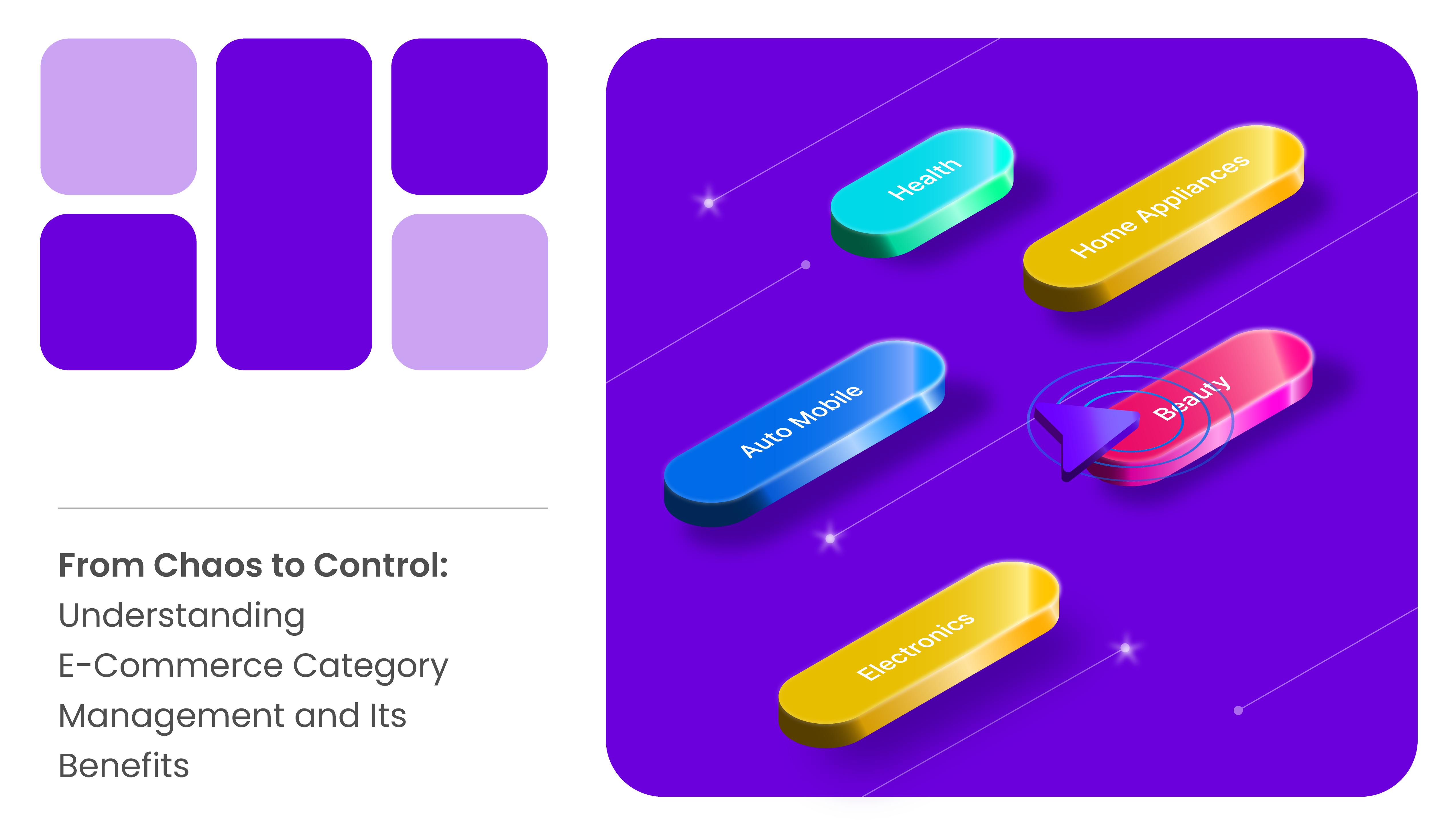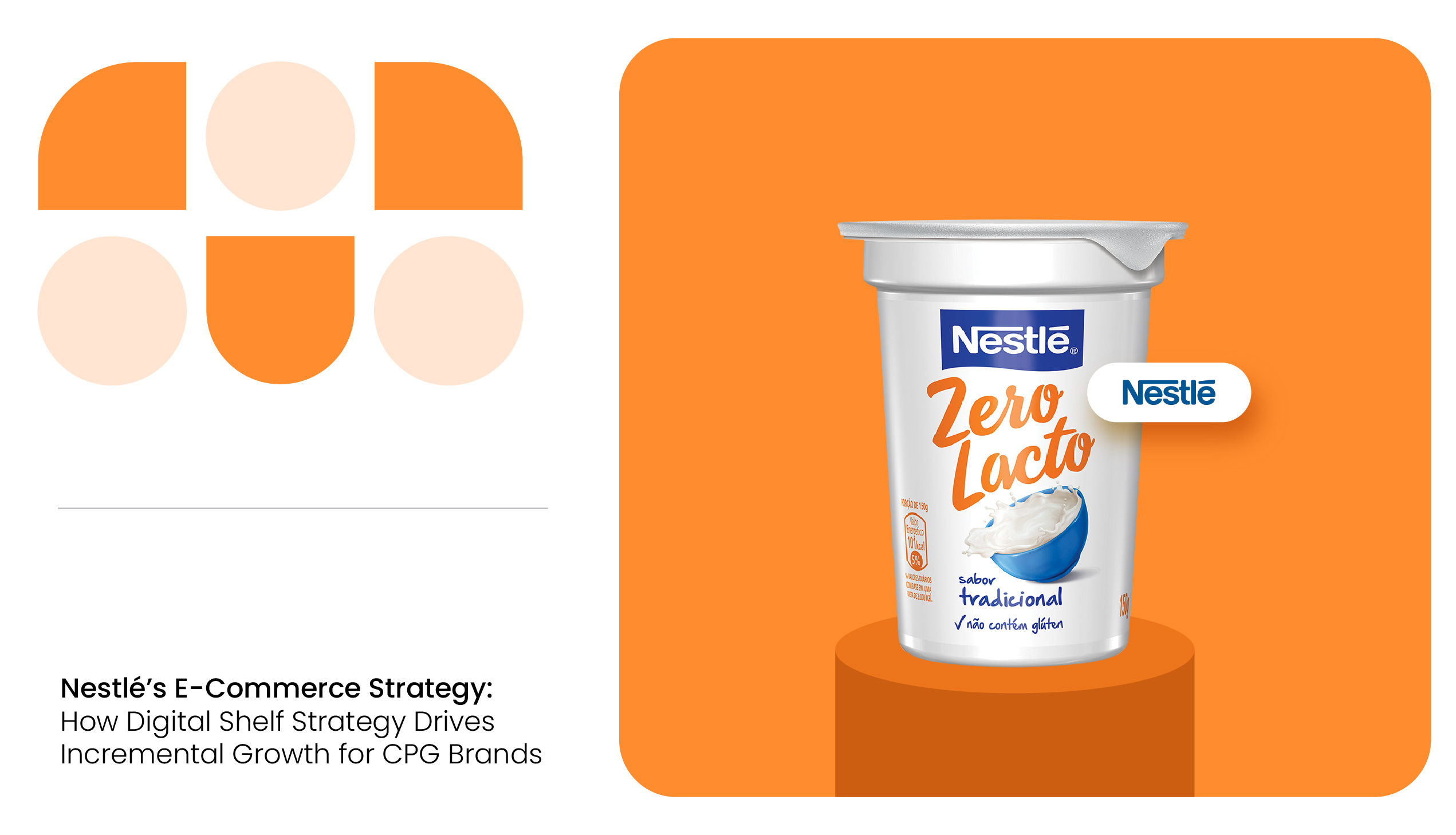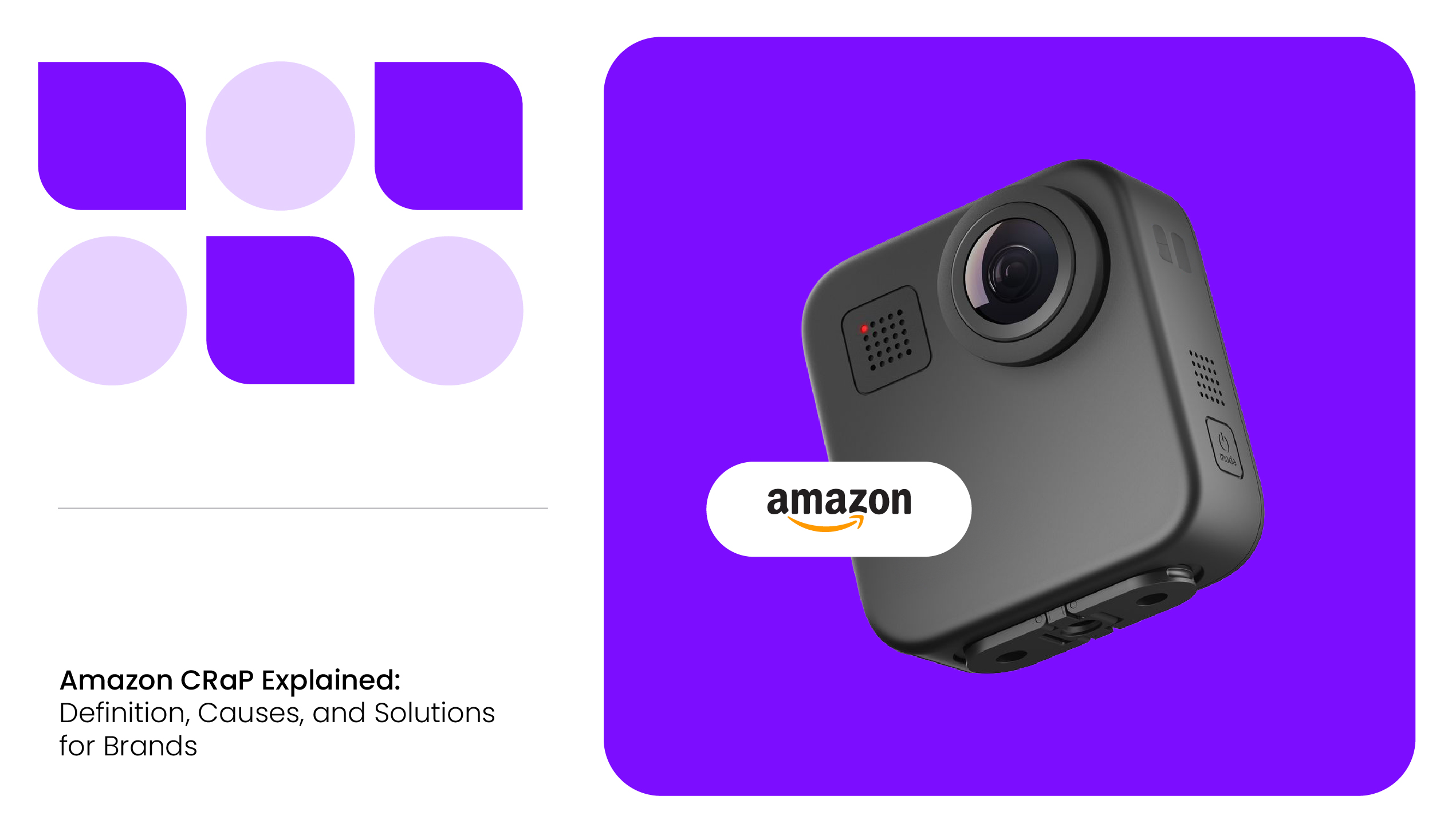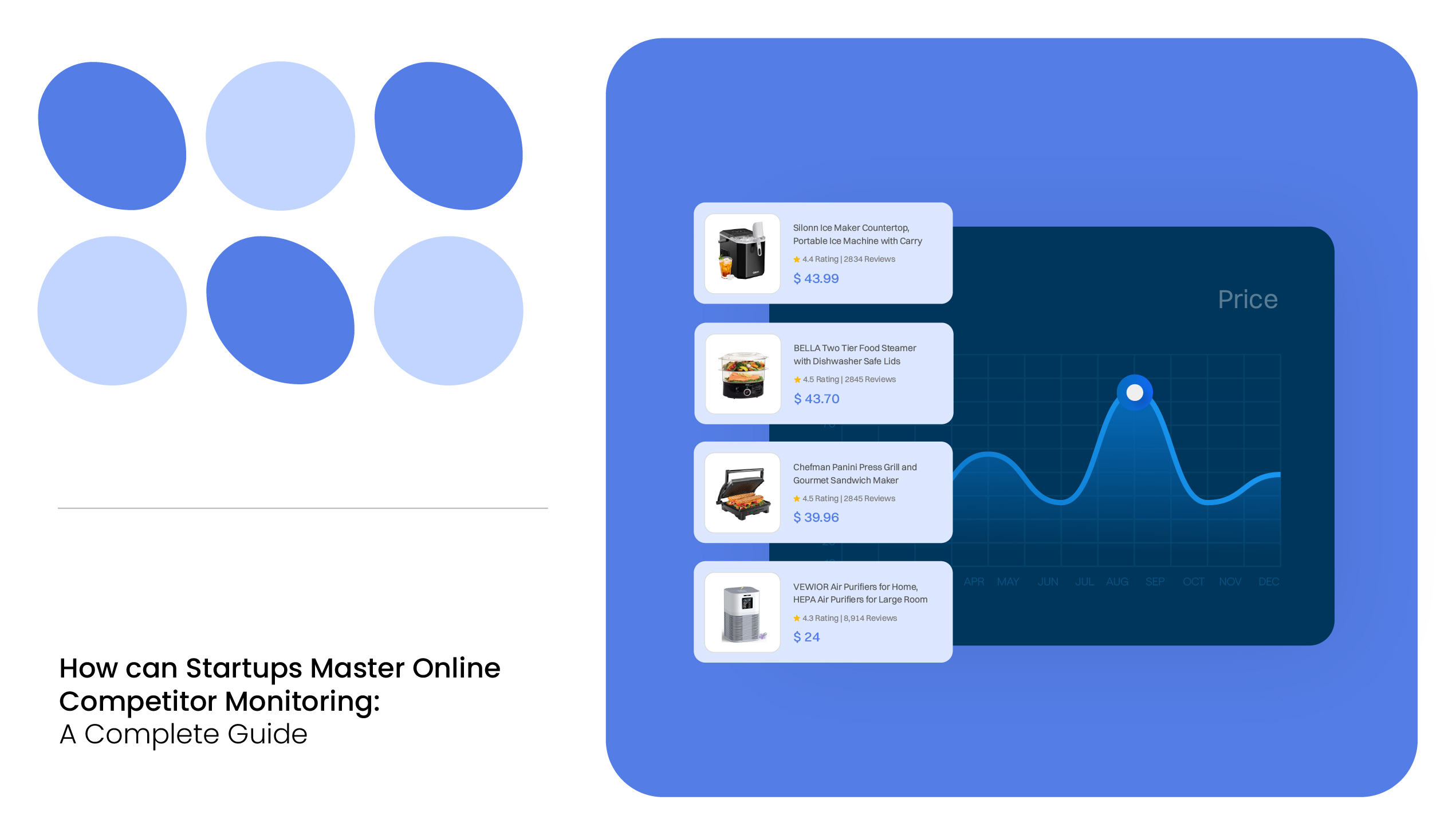E-commerce is characterized by an overwhelming volume of products, fast-changing consumer preferences, and intense competition. Without digital category management, brands risk poor product visibility, inefficient inventory management, and suboptimal pricing strategies.
A strong e-commerce category management strategy ensures that:
- Products are strategically grouped to make browsing and purchasing more effortless for customers.
- Pricing is competitive while maintaining profitability.
- Inventory is optimized, reducing stockouts and excess inventory situations.
- Promotions are data-driven, increasing engagement and conversions.
With category management in e-commerce, brands and retailers can take a systematic approach to decision-making backed by real-time insights from digital shelf analytics software and AI-powered data tools.
What Is Category Management?
Category management, or the Catman process, is a strategic approach to managing product groups in a way that optimizes sales, enhances customer experience, and drives profitability. In e-commerce, category management involves the organization, pricing, assortment, and promotion of products to align with consumer demand and business goals.
Unlike traditional retail, e-commerce category management (eCatman) extends beyond physical shelf space constraints and relies heavily on data-driven decision-making. Brands and retailers use online category management to track customer preferences, monitor competitor pricing, and optimize product placements across digital channels.
A well-structured category strategy for e-commerce helps businesses navigate the complexities of online retail, ensuring that products are discoverable, competitively priced, and positioned for conversion. This approach requires continuous monitoring of market trends, competitor activities, digital shelf optimization, and shopper behaviors to make real-time adjustments.
READ MORE | Interested in knowing about webrooming and showrooming? Check out our blog on Webrooming and Showrooming: Shopping Trends Retailers Shouldn’t Ignore.
Benefits of Category Management in E-Commerce
Category management was initially designed to help brands and retailers organize products within dedicated store aisles, creating a more intuitive shopping experience. By grouping related items, such as skincare products, in the beauty section, this approach maximized shelf space efficiency and guided consumer purchasing decisions.
Effective e-commerce category management also offers several advantages, from improved sales performance to enhanced customer satisfaction. Here are some key benefits:
Enhanced Customer Experience
A well-structured product catalog improves navigation and helps customers find what they need quickly. With the right category strategy in e-commerce, brands can create personalized shopping experiences, reducing friction in the purchase journey.
Increased Sales and Revenue
Strategic pricing, bundling, and promotions based on digital category management insights drive higher conversion rates. Understanding category-level demand helps brands make informed pricing decisions that maximize profitability.
Optimized Inventory Management
Category management e-commerce strategies track demand patterns and market trends to ensure efficient stock planning. This minimizes the risks of overstocking and stockouts, keeping fulfillment operations streamlined.
Competitive Differentiation
With online category management, Catman teams can track competitor activity and adjust their offerings accordingly. Positioning products effectively and responding to market trends can achieve a competitive edge.
Better Marketing and Merchandising Decisions
Insights from digital category management tools enable brands to create targeted promotions that resonate with customers. By identifying which categories and products yield the highest ROI, they can also optimize their advertising spend.
READ MORE | Want to know how to increase your e-commerce sales? Check out our blog on How to Increase E-Commerce Sales?
The Role of a Category Manager in E-Commerce
A category manager is responsible for tracking and analyzing integrated data from both online and in-store sales, e-commerce clickstreams, and inventory fluctuations while incorporating emerging data sources.
They must also possess a deep understanding of the retailer’s e-commerce tech stack and how AI-driven algorithms and machine learning models influence personalized shopping experiences.
Their responsibilities include:
Data-Driven Decision Making
Category managers analyze market trends, customer behavior, and competitor pricing to make informed strategic choices. This ensures that product assortments align with customer preferences and seasonal trends.
Pricing and Promotion Optimization
Effective category management e-commerce requires dynamic pricing strategies based on real-time data. Category managers develop promotional campaigns that drive conversions while maintaining margins.
Collaboration Across Teams
Successful e-commerce category management involves cross-functional collaboration with marketing, supply chain, and sales teams. Category managers ensure that all teams work toward common objectives in product visibility and profitability.
Product Assortment Planning
Category managers assess product performance and introduce new SKUs based on demand trends. They balance product diversity while ensuring that assortments remain relevant and aligned with brand objectives.

How to Improve Your E-Commerce Category Management Strategy
As more customers shop online, your category’s visibility and performance are impacted not only by product quality but also by how effectively products are presented, priced, and positioned on digital platforms.
Category managers need to move beyond intuition and rely on real-time insights to make informed decisions. Here’s how:
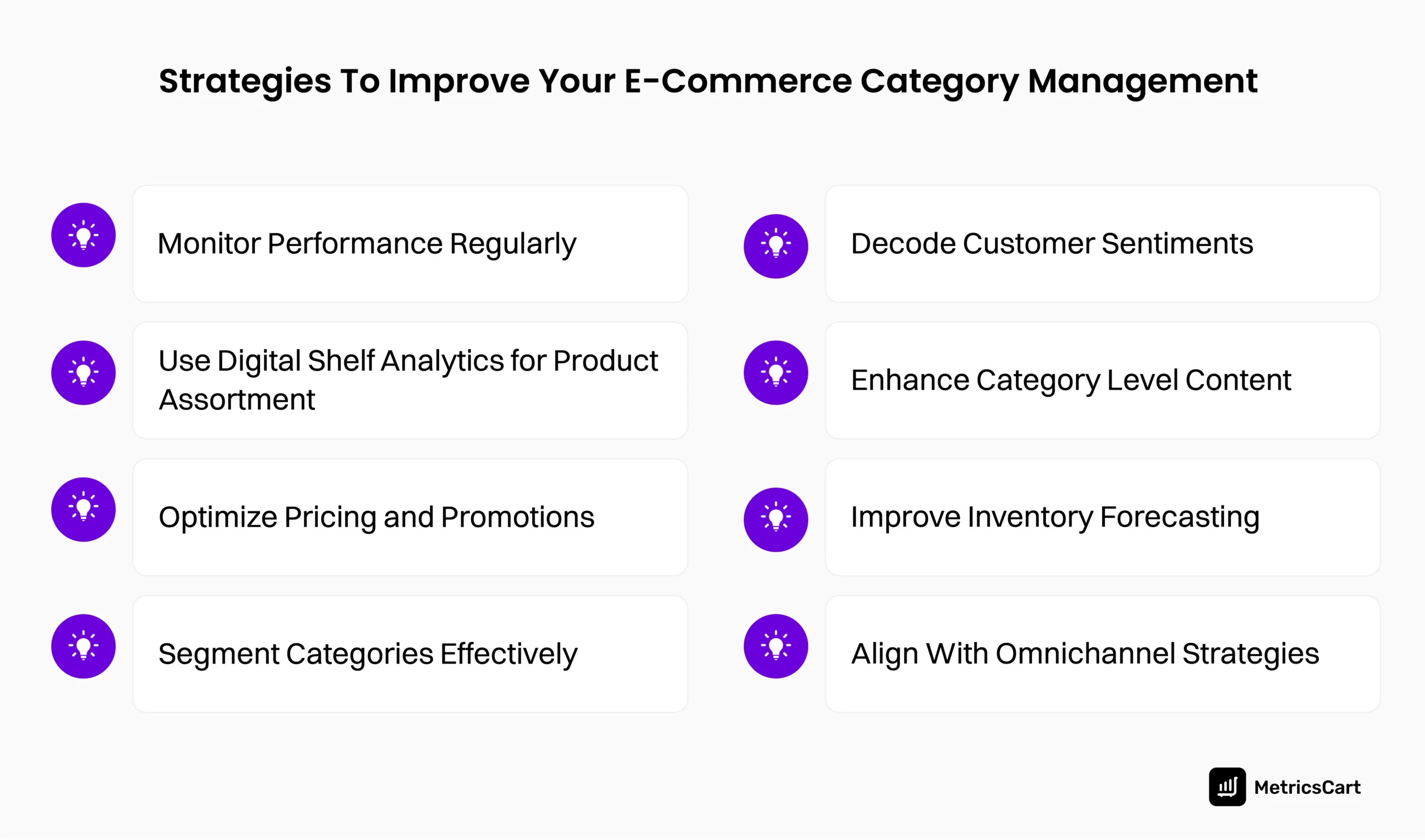
Monitor Performance Regularly
From driving awareness through external traffic sources to improving product selection and basket growth, category managers must analyze critical metrics such as key performance indicators (KPIs), keyword conversion rates, average order value, and cart abandonment.
Assess category performance regularly to identify areas for improvement. Use these insights to refine your approach, ensuring your categories meet customer needs and business goals.
Use Digital Shelf Analytics for Product Assortment
Digital shelf analytics tools like MetricsCart can track online category management metrics like share of search, pricing trends, and competitor activity. Category managers can compare their performance against competitors to refine their pricing and promotional strategies.
Utilize data to identify which products are performing well and remove underperforming items. By understanding which products resonate with your target market, you can make better decisions to optimize the assortment for each category.
Optimize Pricing and Promotions
Real-time category management e-commerce tools help brands analyze market trends and adjust prices dynamically. Identify key product categories that would benefit from discounts, bundles, or seasonal offers.
Strategically plan these promotions to maximize sales during high-traffic periods like holidays or sales events. Regularly analyzing past promotions will also help refine future strategies.
Segment Categories Effectively
Carefully segment products into logical categories and subcategories based on customer needs, buying behavior, and seasonality. A well-organized category structure makes it easier for customers to find products and increases conversion rates. Ensure that your categories are intuitive and tailored to what your customers expect.
Track Customer Sentiment and Reviews
Understanding consumer sentiment through review monitoring enables brands to make data-driven improvements. Digital category management tools can track product feedback and identify opportunities for enhancement, from packaging to product descriptions.
Improve Category-Level Content
Ensure each category page is optimized for customer experience and conversions. Work on providing high-quality images, detailed product descriptions, and informative content. Highlight key benefits and features that appeal to your target customer. The addition of customer reviews can also enhance credibility and improve conversion rates.
Enhance Inventory Forecasting
Data-driven forecasting allows brands to predict seasonal demand, ensuring that inventory is stocked accordingly. Category management e-commerce tools provide insights into supply chain efficiencies and reduce fulfillment disruptions.
Align with Omnichannel Strategies
Incorporating an omnichannel approach ensures that category management strategies work across multiple touchpoints, from online marketplaces to direct-to-consumer websites and physical stores.
READ MORE | Do you know the e-commerce KPIs crucial for brand success? Check out our blog on 6 E-Commerce KPIs for the Digital Shelf: Must-Know Guide for Brands.
Conclusion
Successful eCatman requires aligning brand objectives with retailer goals to create a unified, data-driven strategy. When insights are framed within a broader business narrative, retailers are far more likely to engage and collaborate effectively.
Optimizing product categories using digital shelf analytics solutions like MetricsCart ensures better product visibility, increased sales, and improved customer experiences.
By integrating digital category management solutions, category management teams can move from reactive decision-making to proactive category optimization, setting the foundation for long-term success.
Whether through pricing intelligence, competitive analysis, or demand forecasting, data-powered category management is the key to thriving in today’s digital marketplace.
Ready To Take Your Brand Performance to the Next Level?
FAQ
Effective category management e-commerce strategies ensure the correct product assortment, competitive pricing, and optimized product placement, all of which contribute to higher conversion rates and increased revenue.
The main challenges include poor product discoverability, inefficient inventory management, pricing inconsistencies, and lack of data-driven decision-making. Brands must leverage digital category management tools to track performance and optimize categories in real-time.
Digital shelf analytics solutions like MetricsCart provide real-time insights into pricing trends, share of search, competitor activity, and customer sentiment. This data allows brands to refine their category strategy e-commerce, ensuring better product visibility and sales performance.
Customer feedback provides valuable insights into product performance, quality issues, and pricing perception. Online category management tools can analyze sentiment from reviews and ratings to improve product offerings and marketing strategies.
AI-powered digital category management solutions help brands automate pricing updates, optimize product recommendations, and analyze large sets of consumer data. This enables faster decision-making and better category performance in competitive e-commerce environments.

